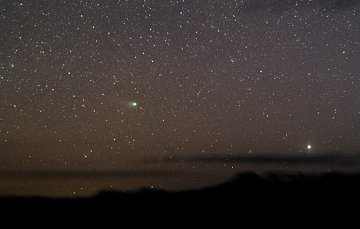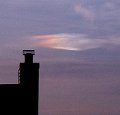 Would you like a call when auroras appear over your home town? Sign up for Spaceweather PHONE.
Would you like a call when auroras appear over your home town? Sign up for Spaceweather PHONE.
AURORA WATCH: Earth is exiting a solar wind stream flowing from a coronal hole on the sun. The chances for a geomagnetic storm or auroras today are subsiding. [gallery]
COMET NEAT: Comet NEAT (C/2001 Q4) makes its closest approach to Earth today. At a distance of 30 million miles, the comet is shining like a 3rd magnitude star--an easy target for binoculars or the unaided eye from dark-sky locations. Look for it after sunset near the southwestern horizon. [sky maps: May 7, May 8, May 9, May 10] [ephemeris]

Above: "Tonight (May 5th), Comet NEAT was visible to the unaided eye before moonrise," says Jimmy Westlake of Colorado. He took this 3-minute exposure on 400-speed film; the comet looks like a green fuzzy blob. Sirius is the bright star on the right.
more images: from Mike Holloway of Van Buren, Arkansas (May 6); from David Tremblay of Alto, New Mexico (30s exp. May 6); from Thad V'Soske of San Diego, California (25s exp., May 6); from Jerry Chab of Lincoln, Nebraska (15s exp. May 6); from Jun Lao at Lake Cowan State Park, south of Wilmington, Ohio (20s exp., May 6); from Dennis Mammana from Borrego Springs, California (15s exposure, May 5); from Jimmy Westlake near Yampa, Colorado (2s exp., May 4);
 RAINBOW SMOKESTACK: The sun was rising over Mason, Ohio, on April 29th when Jun Lao spotted a bright morning sundog (pictured right). "It was situated close to the chimney of a neighbor's house, so that it seemed like colored smoke," says Lao.
RAINBOW SMOKESTACK: The sun was rising over Mason, Ohio, on April 29th when Jun Lao spotted a bright morning sundog (pictured right). "It was situated close to the chimney of a neighbor's house, so that it seemed like colored smoke," says Lao.
Rainbow-colored sundogs like these are caused by airborne ice crystals. Look for them anytime the sun is out and the sky is laced with wispy clouds. Even during hot spring and summer, such clouds are cold enough to freeze water into sunlight-bending crystals.
LUNAR ECLIPSE: Millions of people in Europe, Asia, Africa, Australia and South America watched the Moon turn sunset-red on May 4th when it glided through Earth's shadow--a.k.a. a total lunar eclipse. Visit our gallery to view photos of the eclipse from around the world.

